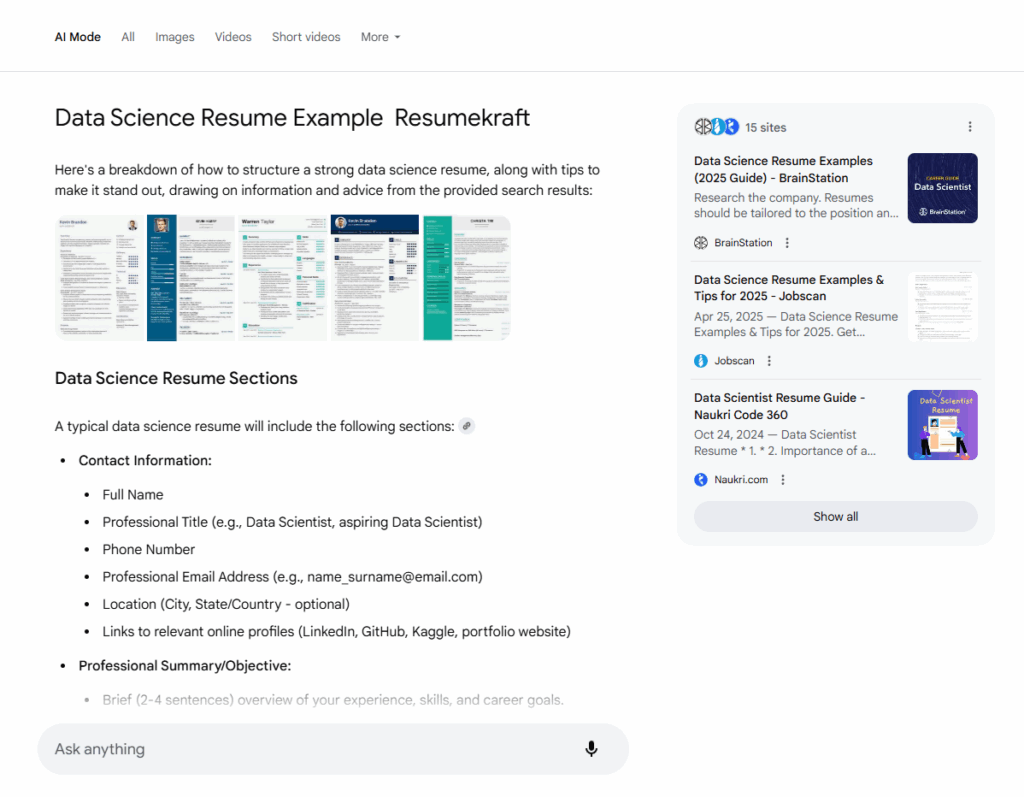
The world of search is undergoing its most significant transformation in a decade. At the heart of this revolution is Google AI Mode, the generative AI-powered experience that now dominates the top of many search engine results pages (SERPs). This isn’t just another feature; it’s a fundamental shift in how users receive information—moving from a list of links to a synthesized, direct answer. For businesses, creators, and marketers, ignoring this change isn’t an option. The question is no longer if you should adapt, but how.
This comprehensive guide will walk you through the intricacies of Google AI Mode. We’ll explore what it is, how it works, and most importantly, provide actionable, in-depth strategies to optimize your content and website to not only survive but thrive in this new AI-driven landscape. The principles of good SEO are still relevant, but the emphasis has shifted. Welcome to the new frontier of search optimization.

1. Understanding the Google AI Mode Engine
Before you can optimize for it, you must understand what you’re dealing with. Google AI Mode is Google’s attempt to provide a single, comprehensive answer to a user’s query directly on the results page. It does this by analyzing and synthesizing information from multiple high-ranking, authoritative web pages.
Think of it as an incredibly advanced research assistant. It reads the top articles on a topic, identifies the key points, corroborates facts, and presents a summarized, easy-to-digest answer, complete with links to its sources.
Key characteristics of Google AI Mode include:
- Synthesis: It combines information from several sources, not just one.
- Direct Answers: It aims to fully answer the user’s question without them needing to click away.
- Prominence: It appears above the traditional “10 blue links,” making it the most valuable real estate on the SERP.
- Source Attribution: It includes links to the websites it used for its summary, driving traffic to those cited sources.
Your goal is to become one of those cited sources. This requires a shift in mindset from simply “ranking #1” to becoming an indispensable, citable authority on your topics.
2. The Core Pillar: Unassailable Content Quality
In the era of Google AI Mode, content isn’t just king; it’s the entire kingdom. The AI is designed to find the most accurate, clear, and helpful information. Low-quality, thin, or keyword-stuffed content will be ignored. Here’s how to ensure your content makes the cut.
Write with Absolute Clarity and Simplicity
AI models process language literally. Complex, jargon-filled prose is harder for them to parse and synthesize.
- Use Simple Language: Write in a clear, concise, and direct style. Use short sentences and paragraphs. The goal is to make your content easily understandable for both a human reader and an AI.
- Answer Questions Directly: Structure your content to answer specific questions. Use headings (H2s, H3s) phrased as questions (e.g., “What is Google AI Mode Optimization?”) and then answer them immediately and comprehensively in the following paragraphs. This makes it easy for the AI to extract the answer.
- Factual Accuracy is Non-Negotiable: Ensure every claim, statistic, and fact in your content is accurate and, where possible, linked to a primary source. Inaccurate information is a major red flag for Google’s systems.
A well-structured article is fundamental. When you create a successful blog within a month, the focus must be on creating a foundation of clear, authoritative posts.
Embrace Structured, Scannable Formats
AI, much like a human reader in a hurry, loves well-organized content.
- Leverage Lists: Use bullet points and numbered lists to break down information into digestible chunks. This format is easily parsed and often pulled directly into AI Mode results.
- Use Tables: For comparisons or data-heavy content, use tables. They structure information in a way that is highly valuable for synthesis.
- Bold and Italicize: Use formatting to emphasize key terms and concepts. This signals importance to the AI.
3. E-E-A-T: The Trust Signal Magnified
E-E-A-T (Experience, Expertise, Authoritativeness, and Trustworthiness) was already crucial for traditional SEO, but it’s even more critical for Google AI Mode. Google will only use sources it deems highly trustworthy to construct its answers.
Demonstrate First-Hand Experience
- Show, Don’t Just Tell: Include case studies, personal anecdotes, original research, and real-world examples. If you’re writing a tutorial, include original screenshots or videos. This proves you have hands-on experience with the topic.
- Author Bios: Have detailed author pages that showcase their credentials, experience, and social media profiles. This connects your content to real, experienced people. A well-crafted bio can function like one of the best Free Resume Templates, quickly establishing credibility.
Establish Expertise and Authority
- Go Deep: Cover topics in exhaustive detail. Don’t just scratch the surface. Your goal is to create the most comprehensive resource on a given subject.
- Cite Sources: Link out to other authoritative websites, studies, and reports. This shows you’ve done your research and are part of the broader expert community.
- Build a Strong Brand: Your overall brand reputation matters. Encourage reviews, seek mentions in reputable publications, and build a strong social media presence. Developing a clear brand persona is a critical first step.
Build Unshakable Trust
- About Us & Contact Pages: Have clear and detailed “About Us” and “Contact” pages. This shows you are a real, accountable organization.
- Secure Your Site: HTTPS is mandatory. It’s a basic but essential trust signal.
- Be Transparent: Clearly label sponsored content or affiliate links. Honesty builds trust with both users and Google.
Ultimately, building trust is one of the crucial elements of a successful business website and a prerequisite for Google AI Mode visibility.
4. Technical SEO and Structured Data: Speaking the AI’s Language
A technically sound website is the foundation upon which great content can be discovered. For Google AI Mode, this extends to using structured data to explicitly tell Google what your content is about.
Flawless Technical Fundamentals
- Mobile-First Indexing: Your site must be perfectly responsive and provide an excellent experience on mobile devices. Use a responsive bootstrap template to ensure compatibility.
- Core Web Vitals: Site speed and stability are paramount. A slow-loading page will be penalized. Focus on optimizing Largest Contentful Paint (LCP), Interaction to Next Paint (INP), and Cumulative Layout Shift (CLS).
- Clean URL Structure: Use simple, logical, and keyword-rich URLs.
yourdomain.com/blog/google-ai-mode-optimizationis far better thanyourdomain.com/p?id=123.
Considering how hosting impacts SEO is vital for maintaining these technical fundamentals.
The Power of Schema Markup
Structured data (or Schema markup) is code that you add to your website to help search engines understand your content more effectively. It’s like creating a name tag for every piece of information on your page.
- FAQ Schema: Mark up question-and-answer sections on your page with FAQPage schema. This directly signals to Google that you are answering specific questions.
- HowTo Schema: For tutorials and step-by-step guides, use HowTo schema. This breaks down the process for the AI.
- Article Schema: Use
ArticleorNewsArticleschema to define the headline, author, publication date, and other metadata about your content. - Person Schema: Use this on your author bios to connect content to a specific, credible individual.
Implementing structured data is a key part of modern web development, and understanding its role is essential for anyone wondering about becoming a web developer.
5. Optimizing for User Intent and Conversational Queries
Google AI Mode is often triggered by longer, more conversational queries. People are starting to ask Google questions as they would ask a person. Your content strategy needs to reflect this.
- Think in Questions: Brainstorm all the possible questions a user might have about your topic. Think about the “who, what, when, where, why, and how.”
- Use Conversational Language: Write in a natural, conversational tone. This will better match the queries that trigger AI Mode.
- Target Long-Tail Keywords: Instead of just “SEO tips,” target “how do I optimize my website for Google AI Mode?” This aligns directly with conversational search.
This approach is central to modern content marketing. Thinking about 5 content marketing tips that work can help you refine your strategy for this new conversational landscape.
Summary Table: Key Optimization Strategies
| Strategy | Description | Key Actions |
|---|---|---|
| Content Clarity | Writing in a simple, direct, and factually accurate manner. | Use short sentences, answer questions directly, verify all facts. |
| E-E-A-T | Proving your Experience, Expertise, Authoritativeness, and Trust. | Create detailed author bios, show case studies, build brand reputation. |
| Structured Content | Using formats that are easy for both humans and AI to scan and parse. | Use lists, tables, bolding, and clear headings (H2, H3). |
| Technical SEO | Ensuring your website is fast, secure, and mobile-friendly. | Optimize Core Web Vitals, use HTTPS, ensure mobile responsiveness. |
| Schema Markup | Adding code to explicitly define your content for search engines. | Implement FAQ, HowTo, Article, and Person schema. |
| User Intent | Aligning content with the conversational questions users are asking. | Focus on long-tail keywords and structure content in a Q&A format. |
6. The Role of Internal and External Linking
Links remain a core signal of authority and context.
- Internal Linking: A strong internal linking structure helps Google understand the relationship between your pages and which content is most important. It also helps spread “link equity” throughout your site. When you write a new post, link back to older, relevant cornerstone content. This is a fundamental part of why business cards are still important in a digital sense—they connect one entity to another.
- External Linking (Outbound): Linking out to other high-authority sites shows that your content is well-researched and positions you as a helpful hub of information. Don’t be afraid to send users to other websites if it provides value.
- Backlinks (Inbound): While you have less direct control over them, earning backlinks from other reputable websites remains a powerful signal of authority. The best way to do this is to create exceptional, link-worthy content.
Just as you would consider improvements to make to your business in 2021, constantly improving your link profile is an ongoing task.
7. What to Avoid: Practices That Hurt Your Google AI Mode Chances
- Keyword Stuffing: Overloading your content with keywords is an old, outdated practice that will get you penalized.
- AI-Generated Fluff: Using AI to generate low-quality, generic content is a losing game. Google’s systems are designed to detect and devalue this. While you can use AI for thoughtful website design, content requires human expertise.
- Poor User Experience: A website cluttered with ads, pop-ups, and difficult navigation will have a high bounce rate, signaling to Google that it’s a low-quality result. Improving your site’s usability is one of the most essential tips for improving your website design.
- Factual Inaccuracies: As mentioned before, this is a major trust-breaker. Fact-check everything.
8. Frequently Asked Questions (FAQs)
Q1: Will Google AI Mode kill website traffic?
This is a major concern. While Google AI Mode provides direct answers, it also provides source attribution links. The goal is to become one of those cited sources. Traffic may become more qualified; users who click through are likely seeking more depth than the summary provides. The key is to create content so comprehensive and valuable that the AI’s summary acts as a teaser, compelling users to click for the full story.
Q2: Is it possible to block my content from being used in Google AI Mode?
Currently, Google does not offer a specific directive to block content from Google AI Mode while remaining in regular search. Using a nosnippet tag would likely remove you from AI Mode and regular snippets, while noindex would remove you from search entirely. The best strategy is to embrace the change and optimize to be a cited source, rather than opting out and losing visibility.
Q3: Does optimizing for Google AI Mode mean keywords are dead?
Not at all. The focus is shifting from short-tail keywords to long-tail, conversational queries. Understanding the language your audience uses to ask questions is more important than ever. Keyword research is still vital, but it must be centered on user intent and natural language.
Q4: How can I track my performance in Google AI Mode?
Tracking this is still an emerging discipline. There isn’t a dedicated report in Google Search Console for AI Mode appearances yet. You can monitor your top queries to see if they trigger AI Mode and watch for changes in impressions and click-through rates. Third-party SEO tools are also beginning to roll out features to track these appearances.
Q5: How is this different from optimizing for Featured Snippets?
The key difference is synthesis. A Featured Snippet usually pulls its answer from a single source. Google AI Mode synthesizes information from multiple sources to create a more comprehensive answer. Therefore, while the optimization tactics are similar (clarity, structured data), the bar for authoritativeness (E-E-A-T) is even higher for AI Mode.
Q6: Should I use AI to write my content to better match the Google AI Mode style?
This is risky. While you can use AI for brainstorming or outlining, relying on it for full content generation is what the article refers to as “AI-Generated Fluff.” Google’s systems are designed to reward authentic, experience-driven content. Your unique insights and first-hand experience are your biggest differentiators. Use AI as an assistant, not as the author.
The Future is Now
Optimizing for Google AI Mode is not about finding a new “hack” or “trick.” It’s about doubling down on the fundamentals of creating high-quality, user-focused content on a technically sound website. It’s about proving your expertise and building a trustworthy brand.
The SERP of tomorrow will be more dynamic and conversational. Businesses that invest in becoming genuine authorities in their niche will be the ones cited in Google AI Mode, earning them visibility, traffic, and trust. The companies that cling to old methods will become invisible. The choice is yours. Start by evaluating your current content against these principles and build a strategy that embraces the future of search. This is how you build a successful online business in the age of AI.
Remember that your website’s design is the container for your excellent content. A corporate free bootstrap responsive web template can provide a solid starting point. For specific industries, like education, a targeted theme like an eLearning free educational responsive web template can be even more effective. Even a simple one-page bootstrap free template can be powerful if it’s well-structured.
As you plan for the future, keep an eye on the top web design trends for 2025 and how they align with AI-first principles. The role of AI in web design itself is growing, creating a feedback loop where AI-friendly design helps you rank in AI-generated results. Your entire digital presence, from your content to your free portfolio website templates, must work in concert. Finally, always remember that the goal is to enhance online visibility by being the most helpful and reliable answer to a user’s question.
 Best Free HTML5 Bootstrap Themes
Best Free HTML5 Bootstrap Themes
